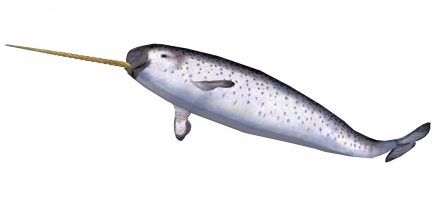Narwhal whale (Monodon Monoceros) is one of the toothed whales. It has a long tusk that sticks out from its canine tooth and rightly called as ‘unicorn of the sea’. It is one of the only two living whale species from the family Monodontidae. Beluga whale is the other one in this family. Belugas and narwhals are also called ‘white whales’.
Narwhal is a medium-sized whale and lacks dorsal fin. It has white body with dark brown spots speckled over it.
Narwhales and belugas are equal in size. Narwhals can grow from 13 to 20 feet in length and weighs around 1,800 to 3,500 pounds. A newborn calf is about 5.2 feet long. The size of its tusk can grow from 4.9 to 10.2 feet long and weigh up to 22 pounds. The tusk is more common in male narwhals while just about 15 percent of females have these tusks. Few narwhals have two tusks, though it is very rare.
Narwhals have a lifes pan of more than 50 years.
pan of more than 50 years.
Male narwhals reach maturity at the age range of 11 to 13 years while females mature after 5 to 8 years. Mating occurs in late April or May. The mother suckles her calf for 20 months.
A female narwhale gives birth to just one calf. Narwhals swim in the Arctic waters along Canada, Russia and Greenland. They are more common in Canadian Arctic Archipelago. During summer, narwhals often huddle together in large numbers and can range from 500 to 1000 members. But during other seasons, this pod (group name) is limited to 15 to 20 individuals.
Typically, narwhals feed on shrimp, Greenland turbot, cuttles, Arctic Cod and Polar Cod as well as armhook squid. In winter, it dives down to a depth of up to 4,920 feet.
The Native American people hunt these whales to get skin and tusks.
Orcas, polar bears, walruses and Greenland sharks are the predators of narwhal whales. Humans also pose significant threat to their survival.
Other Name: Narwhale





